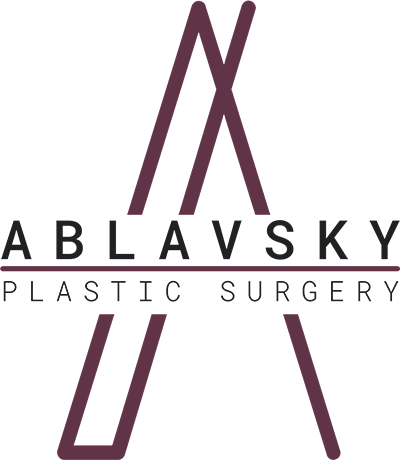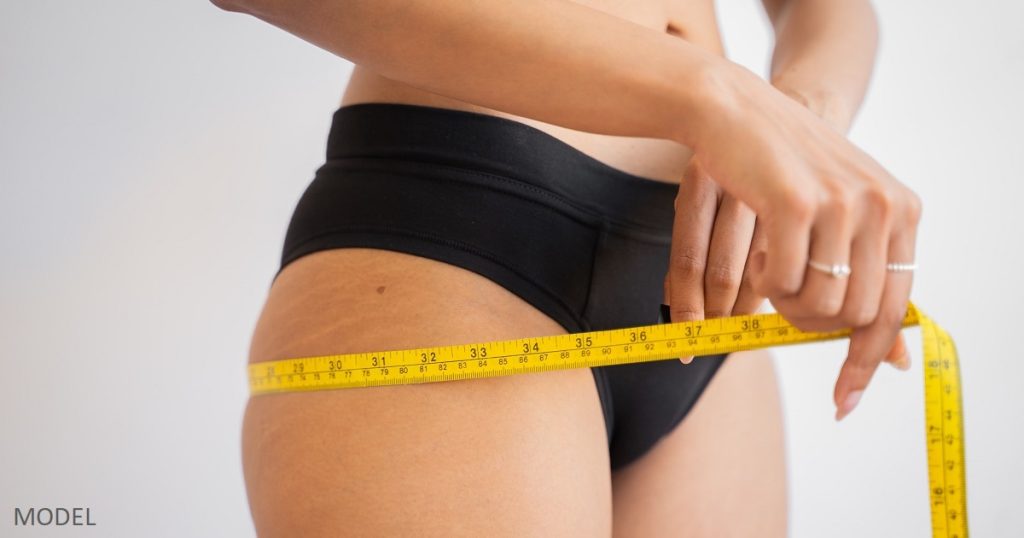At my San Antonio plastic surgery practice, one of the procedures my patients ask most about is liposuction. While this procedure is very popular, there are many misconceptions out there about what can and cannot be accomplished with liposuction. In this blog post, I will answer some common questions to provide detail on how liposuction can remove unwanted fat and reshape your body.
If you are interested in liposuction to reshape your contours and remove unwanted fat, request a consultation or call (210) 942-6672 to make an appointment.
How Does Liposuction Work?
Fat cells (adipocytes) are mostly made up of triglycerides (fat molecules). Multiple fat cells are arranged into lobules and lobules are further separated by fibrous septa. Once a person reaches adulthood the number of fat cells remains relatively the same, but the size of the existing fat cells can change.
Liposuction is a procedure which removes fat and helps shape (contouring) specific areas of the body. The fat removed is under the skin and is called the subcutaneous fat.
Traditional liposuction works by removing fat cells in specific areas. The volume of fat removed depends on the specific area of liposuction, desired result, and the volume of far cells present prior to liposuction.
Liposuction removes and reduces the number of fat cells in two ways.
- 1. Removes fat cells at the time of surgery.
- 2. Causes injury to nearby incompletely suctioned fat cells which then get absorbed by your body in the months following surgery.
What Areas of the Body Can Liposuction Treat?
Liposuction works best to remove pockets of unwanted fat which do not respond well to diet and exercise, rather than treating large sections of fat in any one area.
- Abdomen
- Liposuction 360 to remove fat around the abdomen, sides, and lower back
- Chest (used for male breast reduction or gynecomastia surgery)
- Along the bra line
- Hips
- Inner and outer thighs
- Inside of the knees
- Upper arms (bat wings)
- Upper back/ back of the neck (buffalo hump)
- Under the chin (double chin)
- Along the jawline
It is important to note that while liposuction works to remove unwanted fat, it does not work to tighten loose skin. Removing fat from areas where the skin has been stretched will result in loose, hanging skin, requiring additional surgery to remove the excess skin. In these cases, I recommend combining liposuction with another procedure.
Combining Liposuction with Other Surgical Procedures
For patients who have excess or loose, sagging skin and underlying muscle laxity, I usually recommend combining liposuction with:
- Tummy tuck to contour the waist and tighten the underlying muscles.
- Gynecomastia surgery to reduce the fat and remove excess breast tissue in men.
- Arm lift to reshape the upper arms.
Liposuction is also used for fat grafting procedures. In order to harvest fat to transfer to another part of the body, I perform liposuction to remove the fat cells from one area then inject it into another area of the body or the face to restore fullness where it is desired.
Who Is a Good Candidate for Liposuction?
Ideal candidates for liposuction are overall healthy individuals. Liposuction will have the best results for patients who are of normal weight but have hard-to-lose fat pockets that resist exercise and healthy eating.
Patients with thick skin with good elasticity do better with liposuction. Thin skin with stretch marks does not tend to tighten and bounce back well after liposuction, weight loss, or during the natural aging process and may appear loose after liposuction.
During the consultation, I have the patient point out areas of concern to determine where or if liposuction can be of benefit. After assessing the skin quality, I discuss the possible risks, benefits and whether expectations can be met. Skin with good tone and elasticity will tighten and shape to the treated areas.
Patients interested in liposuction 360 (liposuction of waistline and abdomen) will benefit most if they hold most of their fat under the skin (subcutaneous) as opposed to intra abdominally. Intra-abdominal fat (visceral fat) cannot be removed with liposuction.
Can Liposuction Treat Cellulite?
Liposuction is not performed with the purpose of releasing the fibrous septa which hold fat lobules in place and therefore is not intended for the treatment of cellulite. Liposuction does not help with skin dimples (cellulite) because the fibrous bands that cause cellulite are not removed with liposuction.
How Soon Will I See Results from Liposuction?
Initial changes to your body’s contour can often be seen the day after your surgery on your follow up visit.
In the first week following surgery, swelling will peak, masking the results of liposuction, but you will gradually see changes to your shape after 6 weeks to several months as the swelling goes down after liposuction.
What Are the Risks Associated with Liposuction?
During your liposuction consultation, I will complete a thorough discussion of your goals and expectations and always discuss the risks associated with liposuction surgery.
I will provide you with an informed consent form to sign before you schedule your surgery. This has a comprehensive list of potential complications and includes but is not limited to:
- Bruising
- Bleeding
- Swelling
- Infection
- Skin sensation changes
- Contour irregularities
- Skin excess
- Puncture of vital structures
- Fluid accumulation (seroma)
- Blood clots
- Fat embolism
- Need for revision
- Lidocaine toxicity
- Cardiac/pulmonary issues associated with anesthesia
Bruising and swelling are very common after liposuction. Temporary bleeding, bruising and associated swelling are normal after liposuction procedures. During your consultation, prior to your liposuction procedure, we will discuss stopping NSAIDS (nonsteroidal anti-inflammatory drugs), as well as other medications which can cause thinning of your blood, as this can worsen bruising, swelling, and bleeding after surgery.
Numbness, hypersensitivity, and a burning/ prickling sensation (paresthesia) in the treated area are common side effects of liposuction. These side effects should dissipate over time as the body heals.
Contour irregularities can occur after liposuction. Once the fat is removed, the skin may have a rippled appearance or have bumps which cause an uneven or wavy appearance. As the body heals, the skin should shrink and tighten to reveal the underlying leaner body contour.
Fluid accumulation can also occur after liposuction. These pockets of abnormal fluid accumulation, called seroma, can occur post-operatively. Applying heat to the area can help it drain. If the seroma does not go away on its own, it may need to be drained.
Lidocaine toxicity can also occur after liposuction. Lidocaine is a numbing medication used in the tumescent (fluid injected) prior to the removal of fat. High doses of lidocaine can accumulate in the bloodstream and cause tinnitus, perioral sensation changes, as well as heart and central nervous system problems.
A puncture of or injury to internal organs and vital structures is very uncommon but can be a devastating event. This occurs when the thin tube, known as the cannula, penetrates too deeply.
How Can I Prepare for My Liposuction Procedure?
Before your liposuction procedure, you will be scheduled for pre-operative appointments that include a detailed review of your medical history, any medications and supplements you are taking, and an overall health assessment and optimization. If you are taking any medications that predispose you to bleeding, such as anti-inflammatory drugs, I may recommend stopping them before surgery. If needed, I will send you for lab work in advance of your surgery.
After your surgery, we provide post-operative compression garments that can decrease swelling and improve outcomes from your liposuction procedure.
What Is a Liposuction Procedure Like?
On the day of surgery, I mark the areas to be treated and identify the fat pockets planned to be removed with liposuction. These markings allow me to take an individualized approach to address your specific concerns and goals.
When performed at an outpatient surgery center, liposuction of up to 5 liters may be performed. This equates to approximately 10 pounds. For liposuction of larger areas or when liposuction is combined with another procedure, the surgery is typically performed under general anesthesia. For low-volume liposuction of smaller areas, such as the chin and jawline, liposuction can be performed under local anesthesia.
What Is Recovery Like After Liposuction?
Recovery varies for each patient – age, overall health, areas treated, as well as volume of fat removed are all factors that affect your recovery process.
Most liposuction procedures I perform are outpatient. This means you can go home the same day as your surgery. Pain and discomfort can be expected in the first few days after liposuction, but this will subside after 2-3 weeks.
I encourage patients to walk following surgery, but I recommend avoiding strenuous activity to minimize bruising and swelling.
After surgery, I leave some of the liposuction incisions open to allow fluid to drain out. I will also prescribe compression garments to help reduce swelling and promote healing. Compression garments are important in the post-operative period. Compression helps reduce swelling and allows the skin to tighten and reshape to your new contour. Patients are encouraged to wear compression garments for 4-6 weeks after surgery for optimal results.
After 6 weeks, the majority of your swelling should resolve, and you should start to see an improvement in the treated areas, but it may take several months to see final results.
Take the Next Step
If you are ready to schedule your liposuction consultation, please request a consultation online or call (210) 942-6672 to schedule an appointment.


Leave a Reply